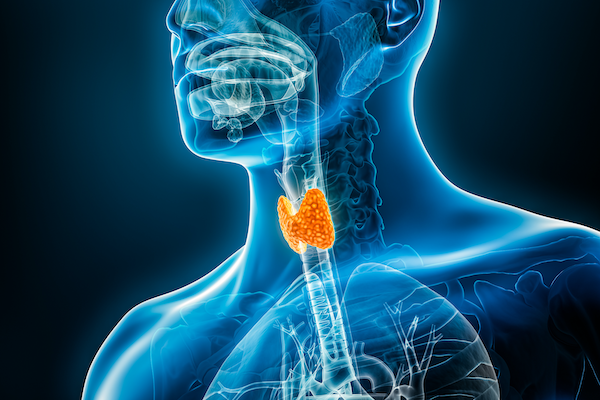Thyroid
Located in the low neck, the thyroid gland produces thyroid hormone, which acts to keep the body’s various systems running. Thyroid glands are somewhat prone to developing growths, some of which produce an excess of thyroid hormone, others not; some are malignant and can spread to other parts of the body, others benign.
Thyroid gland
Thyroid lobes and the isthmus. This image is oriented as if the individual were facing you, and the right thyroid lobe is the individual’s right.
About the thyroid gland
The thyroid gland is a small butterfly-shaped gland located in the neck. The thyroid gland produces thyroid hormone, which is an essential driver of metabolism and many organ functions.
The thyroid gland is located in the low neck, draped across the windpipe just above the sternum.
Functioning as the master regulator of metabolism, the thyroid gland plays a vital role in the body's overall energy balance. It produces two main types of thyroid hormone, namely thyroxine (T4) and triiodothyronine (T3), which are released into the bloodstream.
These hormones have important functions in controlling the body's metabolism, growth, and development.
Regulating the production of thyroid hormone depends on a negative feedback loop. Thyroid Stimulating Hormone (TSH) is produced in the pituitary gland and activates the thyroid to produce more thyroid hormone. Low levels of circulating thyroid hormone are sensed by the hypothalamus in the brain, causing it to produce more thyrotropin releasing hormone (TRH). The pituitary senses the low thyroid hormone and the high TRH, causing it to release more TSH. This, in turn, increases the thyroid gland’s production of thyroid hormone, resolving the problem. Similarly, high thyroid hormone levels in the blood leads to lower TRH and TSH production, which then acts to decrease thyroid hormone function.
Thyroid hormone made in the thyroid consists of two subtypes, T4 and T3. Although T4 is the relatively inactive form of the hormone, most of it gets converted into the active T3 hormone within the body's tissues. T3 hormone acts on virtually every cell in the body, regulating their metabolism and promoting growth and development.
Without adequate thyroid hormone, either due to the gland’s insufficient production due to disease, radiation, or from surgical removal of the gland, a hypothyroid state develops in which an affected individual may begin to become fatigued, gain weight, tolerate cold temperatures poorly, and experience a poor cognitive function and depression.
A hyperthyroid state is when too much thyroid hormone, either from an overactive thyroid gland (or part of it), or an excess of thyroid hormone replacement medication leads to symptoms of anxiety, jitteriness, tremor, a faster and even irregular heart rate, as well as bone density loss. Thyroid hormone itself contains iodine, which must come from our diet, and the thyroid is the only organ that uses iodine.
The thyroid gland also produces another type of hormone called calcitonin. This hormone helps decrease the amount of calcium in the blood. Whereas thyroid hormone is made by the follicular cell of the thyroid gland, calcitonin is made by a less populous cell in the thyroid gland called the parafollicular C cell.
The thyroid may be affected by inflammation. This may occur due to an infection from bacteria (as in acute thyroiditis) or from a virus (as in subacute thyroiditis) or from an autoimmune condition as in Graves’ disease and Hashimoto’s thyroiditis).
Testing for hyperthyroidism and hypothyroidism
Testing for hyperthyroidism and hypothyroidism typically involves a combination of blood tests and clinical assessments. To diagnose hyperthyroidism, doctors often measure the levels of thyroid stimulating hormone (TSH) with a blood draw. The pituitary regulates thyroid hormone production by releasing more or less TSH into the bloodstream. Normally, when the body needs more thyroid hormone, this is sensed by the pituitary gland and it produces more TSH. Thus, high TSH is generally an indicator of low thyroid hormone. Inversely, when the body has too much thyroid hormone, the pituitary gland produces less TSH.
Testing for T3 and T4 levels may also be undertaken to supplement the information gleaned from measuring the TSH level.
Additionally, other tests, like thyroid antibody tests and imaging studies, may be ordered to further evaluate the condition and identify the underlying cause.
Thyroid nodules
Thyroid nodules are abnormal growths that develop on the thyroid gland. It is important for individuals with thyroid nodules to undergo evaluation, including blood testing and ultrasound imaging to evaluate for potentially dangerous conditions of hyperthyroidism, hypothyroidism, thyroid cancer, and/or compression of the nearby airway or esophagus. Nodules that are suspicious for cancer may undergo fine needle aspiration biopsy.
Goiter
A goiter is an enlarged thyroid, which could arise from multiple causes. A goiter may become large enough to be visible in the neck, compress the airway or esophagus, or extend into the chest, called a substernal goiter.
Graves disease
Graves disease, also known as toxic diffuse goiter, is an autoimmune disorder that primarily affects the thyroid gland and causes hyperthyroidism and eye problems.
Hashimoto’s Thyroiditis
Hashimoto's thyroiditis is a common autoimmune disorder that eventually causes hypothyroidism.
Subacute Thyroiditis
Subacute thyroiditis is a condition characterized by the inflammation of the thyroid gland that occurs over a timeframe of about 2-4 months. There are two distinct types of subacute thyroiditis: subacute lymphocytic thyroiditis, which is painless, and subacute granulomatous thyroiditis, which is painful.
Acute Thyroiditis
Acute thyroiditis is a condition characterized by the sudden development of inflammation and pain of the thyroid gland, usually in one subsite of the thyroid gland rather than the entire gland. Bacterial infections are the usual cause of acute thyroiditis.
HOW TO GET THE MOST FROM YOUR APPOINTMENT
Appointment time is valuable. Below are some suggestions to make the most of your appointment. This preparation will help you and your doctor maximize efficiency and accuracy, freeing up time for questions and answers.
This page









